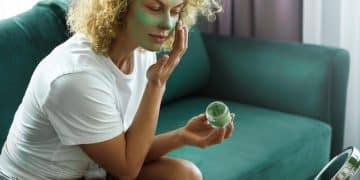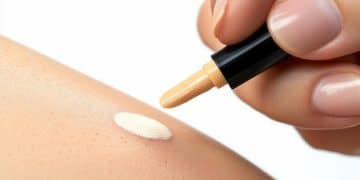Makeup for Mature Skin: How to Achieve a Youthful Glow
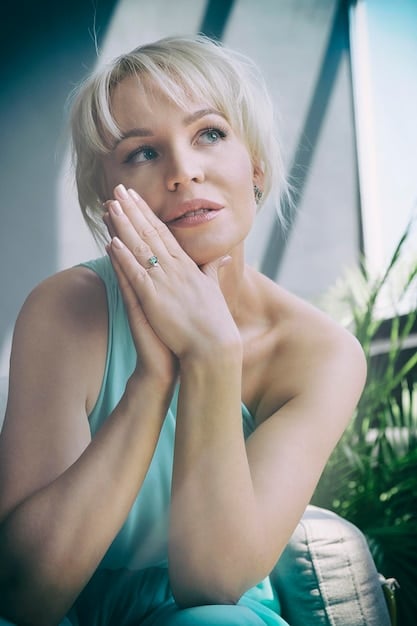
Anúncios
Achieving a youthful glow with makeup on mature skin involves a strategic approach focusing on hydration, light-reflecting formulas, and techniques that enhance natural features while minimizing the visibility of fine lines and wrinkles for a radiant and fresh appearance.
As we age, our skin undergoes various changes, from loss of elasticity to the appearance of fine lines and wrinkles. Navigating the world of cosmetics can feel overwhelming, but mastering makeup for mature skin: how to achieve a youthful glow is entirely within reach. This guide will explore practical techniques and product recommendations designed to enhance your natural beauty, leaving you with a radiant, fresh, and age-defying look.
Anúncios
Understanding Mature Skin Needs
Mature skin presents unique challenges and opportunities when it comes to makeup application. As we age, our skin tends to become drier, collagen production decreases, and fine lines and wrinkles become more prominent. These changes necessitate a shift in our beauty routines, moving away from heavy, matte products that can settle into lines and instead embracing formulas that hydrate, illuminate, and provide a soft, diffused finish.
The primary goal is not to mask or conceal every sign of aging, but rather to enhance your features and create a seamless, youthful luminosity. Understanding these fundamental shifts in skin characteristics is the first step toward building an effective and flattering makeup routine.
Hydration is Your Best Friend
Proper skin preparation is paramount for mature skin. A well-hydrated canvas ensures that makeup applies smoothly, wears beautifully throughout the day, and looks less likely to settle into fine lines. Think of your skincare routine as the foundation for your makeup—it’s crucial.
Anúncios
- Start with a hydrating cleanser: Avoid harsh cleansers that strip natural oils. Opt for creamy or oil-based cleansers that leave your skin feeling soft and supple.
- Apply a rich moisturizer: Choose a moisturizer packed with humectants like hyaluronic acid and emollients or ceramides. Apply it generously and allow it to fully absorb before moving on to makeup.
- Consider a hydrating primer: A good primer can create a smooth surface, fill in fine lines, and extend the wear of your makeup. Look for primers specifically designed for hydration or those with a luminous finish.
Beyond daily routines, incorporating a hydrating facial oil or a rich night cream can significantly improve skin texture over time, leading to a more youthful overall appearance. Remember, makeup can only look as good as the skin beneath it.
The Importance of Skincare Actives
Beyond basic hydration, incorporating certain active ingredients into your daily skincare regimen can significantly improve the texture and health of mature skin, thereby optimizing it for makeup application. Ingredients like retinoids (retinol), vitamin C, and peptides play crucial roles in cellular turnover, collagen production, and antioxidant protection.
Retinoids, for instance, are celebrated for their ability to reduce the appearance of fine lines and wrinkles by promoting cell renewal. Vitamin C brightens the complexion and protects against environmental damage, while peptides can help to improve skin firmness. Consistent use of these actives prepares the skin, making it more receptive to makeup and contributing to that desired youthful glow from within.
By treating the skin well before makeup application, you’re not just covering up; you’re starting with a healthier, more vibrant base. This integrated approach ensures that your makeup enhances, rather than detracts from, your natural radiance.
Foundation and Concealer for a Luminous Finish
When selecting foundation and concealer for mature skin, the goal is to achieve an even complexion without creating a heavy, mask-like effect. The key lies in choosing products that offer adequate coverage while maintaining a natural, luminous finish. Avoid formulas that are overly matte or thick, as these can accentuate texture and lines.
Instead, gravitate towards liquid or cream formulas that provide hydration and a soft, dewy glow. These types of products blend seamlessly into the skin, offering coverage where needed without settling into creases.
Choosing the Right Foundation Formula
The right foundation can make all the difference in achieving a youthful, luminous complexion. For mature skin, steer clear of full-coverage, matte foundations, which can make skin look flat and can settle into fine lines and wrinkles. Instead, opt for lightweight, hydrating formulas.
- Tinted moisturizers or BB/CC creams: These offer light coverage and hydration, perfect for an everyday, natural look.
- Hydrating liquid foundations: Look for foundations labeled “luminous,” “dewy,” or “hydrating.” They often contain ingredients like hyaluronic acid or glycerin to keep skin plump.
- Serum foundations: These are typically very lightweight, offer light-to-medium coverage, and often include skincare benefits.
When applying, use a damp beauty sponge or your fingertips to gently press the product into the skin, starting from the center of your face and blending outwards. This technique ensures a natural finish and helps to avoid product buildup in areas prone to creasing.
Strategic Concealer Application
Concealer application on mature skin requires a delicate touch. The common mistake is to apply too much, which can draw attention to fine lines rather than concealing them. Focus on strategic placement and blending.
- Use a creamy, hydrating concealer: Avoid thick, dry formulas. Look for concealers that offer light-to-medium coverage and have a radiant or luminous finish.
- Target only necessary areas: Apply concealer only where you need it most—typically under the eyes to brighten dark circles, around the nose to neutralize redness, or on any specific blemishes or age spots.
- Apply sparingly: Use a small amount, dotting it onto the skin, and then gently tap and blend with your ring finger or a small, fluffy brush. The warmth from your finger can help the product melt into the skin beautifully.
Setting your under-eye concealer with a tiny amount of translucent, finely milled powder can prevent creasing, but use a light hand. The goal is to set, not to mattify.
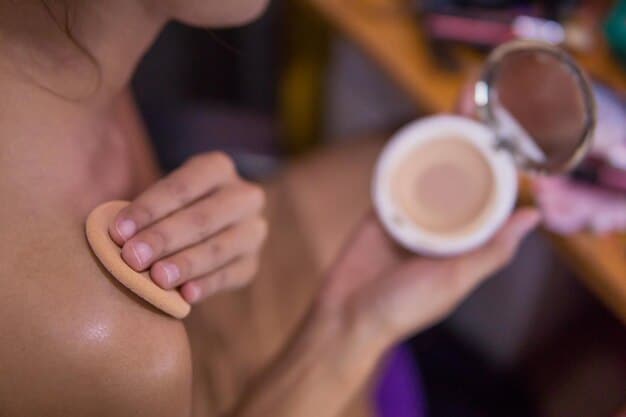
Bringing Life to Your Face with Color
Color choices play a significant role in creating a youthful and vibrant makeup look. As skin matures, it can lose some of its natural flush, making the strategic application of blush, bronzer, and highlighter essential. The key is to choose shades and formulas that add warmth, dimension, and a healthy glow without appearing harsh or overdone.
Cream and liquid formulas are often preferred for mature skin as they blend seamlessly, offering a more natural finish compared to powders that can sometimes emphasize texture.
Blush for a Youthful Flush
Blush is arguably one of the most transformative products for mature skin, instantly adding a healthy, youthful flush. The right shade and placement can make you look more awake and vibrant.
- Opt for cream or liquid blushes: These formulas melt into the skin, providing a dewy, natural finish that looks like a natural flush. They are less likely to settle into fine lines than powder blushes.
- Choose soft, warm shades: Peaches, soft pinks, and rose tones are universally flattering. Avoid anything too bright or cool-toned, which can sometimes appear jarring.
- Apply to the apples of your cheeks: Smile to locate the fullest part of your cheeks, then blend the blush upwards towards your temples. This lifts the face and provides a natural-looking glow.
Apply blush with a light hand and build up the intensity if needed. The goal is a subtle hint of color, not a heavily made-up look. A well-placed blush can instantly enliven your complexion.
Strategic Bronzer and Highlighter
Bronzer and highlighter, when used thoughtfully, can add dimension and a radiant glow to mature skin. The trick is to apply them in a way that softly sculpts and illuminates, rather than creating harsh lines or glittery patches.
Bronzer for Warmth
For mature skin, bronzer should be used to add warmth and a sun-kissed effect, not to contour dramatically. Look for matte or satin-finish bronzers that are one or two shades darker than your natural skin tone. Avoid anything too shimmery, as glitter can emphasize texture.
Sweep a fluffy brush with bronzer where the sun would naturally hit your face: forehead, cheekbones, and a touch on the bridge of your nose and chin. This adds a healthy glow without a heavy appearance.
Highlighter for Radiance
Highlighter is wonderful for creating a luminous, youthful glow, but placement is key. Avoid highlighters with large glitter particles. Instead, choose liquid or cream highlighters with a finely milled shimmer or a pearlescent finish.
Dab a tiny amount onto the high points of your face: the tops of your cheekbones, brow bone, and cupid’s bow. These areas naturally catch the light, and a subtle highlight here can make your skin look more radiant and lifted. Blend well to ensure a seamless, natural sheen.
The combination of a soft blush, a touch of bronzer for warmth, and strategic highlighting creates a harmonious look that enhances your natural bone structure while imparting a fresh, youthful radiance. The emphasis is always on subtly enhancing, not overpowering.
Eyes That Radiate Youth
The eyes are often the first place to show signs of aging, from fine lines around the outer corners to hooded eyelids. However, with the right techniques and products, you can make your eyes look brighter, more open, and truly radiant. The key is to avoid heavy, harsh applications and instead focus on subtle enhancements that lift and define.
Cream eyeshadows and soft, blendable liner formulas often work best, as they are less likely to crease and are easier to work with on skin that may have more texture.
Eyeshadow Techniques for Lift and Brightness
When it comes to eyeshadow for mature eyes, less is often more. Heavy or shimmery shadows can settle into creases and accentuate texture. Instead, focus on creating a soft wash of color and strategic brightening.
- Use neutral, matte shades: Browns, taupes, and soft grays work well for the crease to add definition without being too harsh. Matte shades are generally more forgiving than shimmers on textured eyelids.
- Apply lighter shades to the lid: A light, shimmery shade on the center of the lid can open up the eye and make it appear more awake. Opt for finely milled shimmers, not glitter.
- Focus on blending: Seamless blending is crucial to avoid harsh lines that can age the eye. Use soft, fluffy brushes.
Consider using an eyeshadow primer to prevent creasing and extend wear. This also creates a smoother base for color application. The goal is to define the eye gently and make it appear more open and vibrant.
Liner and Mascara for Defined Eyes
Eyeliner and mascara can significantly enhance the eyes, but technique is vital for mature skin. Harsh, thick lines can drag the eye down, while clumpy mascara can emphasize the look of thinner lashes.
- Soft eyeliner: For a lifted effect, apply a soft brown or black eyeliner along your upper lash line, focusing on the outer two-thirds. A small wing, gently flicked upwards, can provide a subtle lift. Consider using a kohl pencil or gel liner that can be easily smudged for a diffused look.
- Tightlining: Applying liner along your upper waterline (tightlining) can make lashes appear denser without a visible line.
- Volumizing and lengthening mascara: Choose a mascara that adds both volume and length without clumping. Curling your lashes before applying mascara can also make your eyes appear more open.
Avoid harsh liquid liners on the lower lash line, which can look dated and heavy. If you wish to define the lower lash line, use a very small amount of eyeshadow, softly blended. The overall aim is to define the eyes in a way that makes them appear brighter and more open, contributing to an overall youthful and radiant appearance.
Brows and Lips: The Finishing Touches
While often overlooked, well-groomed brows and carefully chosen lip colors are essential for completing a youthful and polished makeup look. Brows frame the face, and as we age, they can become sparse, while lips can lose their natural fullness and definition. Addressing these areas effectively can significantly enhance your overall appearance.
The aim is to restore volume where it’s been lost and to define features softly, contributing to a harmonious and balanced aesthetic that radiates youthfulness.
Defining and Filling Sparse Brows
Brows are crucial for framing the face and can make a significant difference in a youthful appearance. As we age, brows can become sparse or lose their natural shape. The goal is to fill them in naturally, not to draw on harsh, blocky lines.
- Choose the right product: Brow pencils, powders, or tinted gels are all excellent options. Pencils and powders allow for creating hair-like strokes, while tinted gels add volume and hold.
- Match your brow color: Select a shade that matches your natural brow hair or is one shade lighter, especially if your hair is dark. Using a shade that is too dark can look harsh.
- Focus on sparse areas: Use small, feathery strokes to fill in gaps. Brush your brow hairs up and out to create a fuller, natural look.
Well-defined brows instantly lift the entire face and provide a polished framework for your eyes, contributing significantly to a more youthful and alert expression.
Lip Color and Definition
As we age, lips can lose their natural color and plumpness, and fine lines can appear around the mouth. The right lip products can restore definition and fullness, giving a softer, more youthful look.
- Use lip liner: A lip liner in a shade close to your natural lip color or lipstick can prevent feathering and provide definition. Line just outside your natural lip line for a subtle plumping effect.
- Hydrating lipsticks or tinted balms: Avoid overly matte or dark lipsticks, which can make lips appear thinner. Opt for satin, creamy, or sheer formulas that provide hydration and a soft sheen. Nude, pink, or berry tones are often very flattering.
- A touch of gloss: A dab of clear or tinted gloss in the center of your lips can create an illusion of fuller, more luscious lips.
The goal is to select lip products that hydrate, provide a flattering wash of color, and enhance the natural shape of your lips without drawing attention to fine lines around the mouth. A well-chosen lip color can brighten your entire complexion.
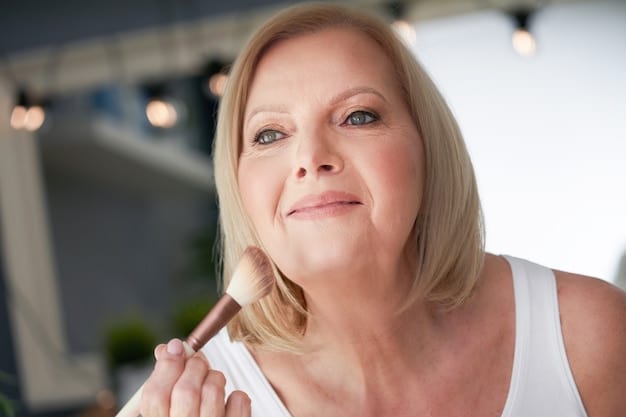
The Power of Lighting and Application Techniques
Beyond the products themselves, the way you apply makeup and the environment in which you do it profoundly impact the final result, especially for mature skin. Good lighting ensures you can see exactly where product is going, preventing over-application or patchiness. Furthermore, specific application techniques can help to lift, smooth, and enhance features without settling into fine lines.
It’s about precision and a light hand, ensuring that every product integrates seamlessly with your skin for a sophisticated and natural finish.
Optimal Lighting for Makeup Application
The type of light you apply your makeup in dramatically affects how it looks in real life. Poor lighting can lead to over-application, incorrect shade matching, and uneven blending, which can be particularly unflattering on mature skin.
- Natural light is best: Position yourself near a window during the day. Natural daylight provides the most accurate reflection of colors and textures, allowing you to see how your makeup will truly appear to others.
- Avoid harsh overhead lighting: This type of lighting can cast shadows, making fine lines and under-eye circles appear more prominent than they are, leading to over-correction.
- Invest in good artificial lighting: If natural light isn’t available, opt for mirrors with LED lights that mimic natural daylight (often labeled “daylight” or “full spectrum” bulbs). Ensure the light source is even and ideally encircles the mirror to prevent shadows.
Applying makeup in proper lighting ensures that your foundation blends seamlessly, your blush is perfectly diffused, and your concealer is undetectable, contributing to a truly flawless and youthful glow.
Mastering the Art of Blending
Blending is arguably the most crucial technique for achieving a youthful and seamless makeup look on mature skin. Harsh lines, unblended edges, or product sitting on top of the skin can instantly age the face. Proper blending ensures products melt into the skin, creating a natural, soft-focus effect.
- Foundation and Concealer: Use a damp beauty sponge, a foundation brush, or your fingertips to press and dab, rather than rub, products into the skin. This technique ensures a smooth, even application without pulling at the skin. Pay special attention to the jawline, hairline, and around the nose.
- Blush, Bronzer, and Highlighter: Apply these products with soft, fluffy brushes or sponges. Blend them in circular motions, ensuring there are no visible lines of demarcation. Cream products can be blended with fingertips for a natural melt.
- Eyeshadow: Use a clean, fluffy blending brush to soften any harsh edges between eyeshadow colors. The goal is a gradient of color that looks effortless and diffused.
Beyond product application, always finish your routine by taking a step back in good lighting to check for any unblended areas. A well-blended face avoids a cakey appearance and instead creates a harmonious, fresh, and truly luminous complexion that enhances your natural beauty.
Addressing Common Mature Skin Makeup Concerns
While the goal is always a youthful glow, mature skin often presents specific challenges like fine lines, wrinkles, dark spots, and dullness, which can sometimes feel counterproductive to achieving a fresh look. Fortunately, there are targeted strategies and product choices that can effectively address these concerns without resorting to heavy coverage or an unnatural finish.
It’s about understanding how products interact with skin texture and making informed choices that smooth, brighten, and unify the complexion for an effortlessly radiant appearance.
Minimizing the Appearance of Fine Lines and Wrinkles
One of the most common concerns for mature skin is the appearance of fine lines and wrinkles. The wrong makeup can unfortunately accentuate these textures. The key lies in hydration, light-reflecting properties, and avoiding products that settle into lines.
- Hydrating Primers: As mentioned, a good hydrating or silicone-based primer can create a smoother canvas, helping to blur the appearance of lines before foundation application.
- Avoid Heavy Powders: Excessive powder, especially matte formulations, can settle into lines and make them appear more prominent. Use finely milled translucent powder sparingly, only in areas that need minimal setting.
- Sheer to Medium Coverage: Opt for foundations and concealers that offer sheer to medium coverage. Thick or full-coverage products, while seeming to offer more concealment, often highlight texture. Look for formulas with “soft focus” or “blurring” properties.
The aim is to bounce light away from lines rather than filling them with heavy product. This approach results in a softer, more diffused appearance that is far more flattering.
Brightening Dullness and Age Spots
Dullness and hyperpigmentation (like age spots) are common concerns that can detract from a youthful glow. Strategic product choices and application can effectively brighten and unify the complexion.
- Color Correction: For severe dark spots or dullness, a light peach or orange color corrector can be used sparingly before foundation. This neutralizes discoloration, allowing less foundation to be needed.
- Radiant Formulas: Incorporate foundations, concealers, and even primers with luminous or radiant finishes. These products contain light-reflecting particles that can diffuse light, making the skin appear brighter and more even-toned.
- Broad-Spectrum SPF: While not a makeup product, daily use of a broad-spectrum SPF is fundamental. It prevents further age spot formation and dullness caused by sun exposure, ensuring your brightened complexion is maintained long-term.
By focusing on products that offer light-reflecting properties and targeting discoloration with gentle correction, you can achieve a significantly brighter and more uniform skin tone, which, in turn, contributes to a vibrant, youthful appearance. Remember, a light hand ensures the most natural and effective results.
| Key Point | Brief Description |
|---|---|
| 💧 Hydration First | Prioritize skincare that deeply hydrates to create a smooth canvas for makeup. |
| ✨ Luminous Formulas | Choose dewy foundations, creamy blushes, and subtle highlighters. |
| 🎨 Strategic Application | Apply with a light hand, focus on blending, and use proper lighting. |
| 👁️🗨️ Enhance, Don’t Mask | Focus on brightening eyes, defining brows, and using soft lip colors to complement natural features. |
Frequently Asked Questions About Makeup for Mature Skin
The most crucial step is thorough hydration and skin preparation. Mature skin tends to be drier, so starting with a well-moisturized and primed canvas ensures makeup applies smoothly, looks natural, and doesn’t settle into fine lines. This foundation helps all subsequent makeup steps look better and last longer, contributing to a truly youthful glow.
While some powder can be useful, use it sparingly. Heavy or matte powders can settle into and accentuate fine lines and wrinkles. Opt for a finely milled, translucent powder applied only to areas that truly need it, like the T-zone, and use a light hand. Cream or liquid formulations are generally more flattering for mature skin.
To make your eyes look younger, focus on brightening and lifting. Use a brightening primer, apply light, matte eyeshadows on the lid and a slightly darker matte in the crease for definition. Curl your lashes and use a lengthening mascara. Avoid harsh liquid liners and heavy shimmers that can settle into creases, opting for soft, smudged liner instead.
The best foundations for mature skin are hydrating liquid, serum, or tinted moisturizer formulas with a luminous or dewy finish. These formulas provide comfortable wear, offer light-to-medium coverage, and reflect light to create a youthful glow, rather than settling into fine lines. Avoid heavy, matte, or full-coverage foundations that can look flat and accentuate texture.
Yes, bright lip colors can be beautiful on mature lips! However, choose formulas that are hydrating and offer a satin or creamy finish, rather than ultra-matte ones, which can make lips appear thinner. Always use a lip liner close to your natural lip color or lipstick shade to prevent feathering and define the lip shape, ensuring a polished look.
Conclusion
Achieving a youthful glow with makeup on mature skin is not about attempting to turn back the clock, but rather about embracing the beauty of experience and enhancing your natural radiance. The principles are simple yet profound: prioritize hydration, select light-reflecting and creamy formulas, and master the art of subtle application. By focusing on nourishing your skin, choosing products that illuminate rather than conceal, and applying them with a gentle hand and precise techniques, you can create a look that is fresh, vibrant, and effortlessly beautiful. Remember, makeup for mature skin is about celebrating your unique beauty and allowing your inner glow to shine through.




